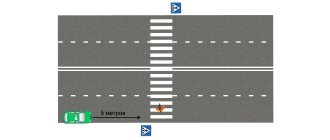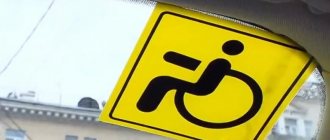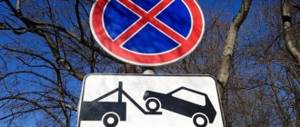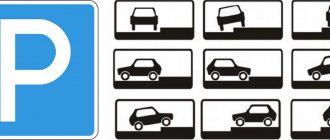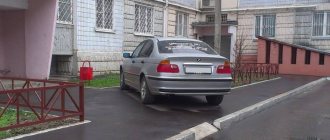Any citizen who gets behind the wheel of a car must comply with the Traffic Rules and other regulations governing the movement of vehicles, as well as their parking.
Parking on the lawn is one of the most controversial violations. Federal law does not establish penalties for this action. The legality of holding a car owner liable is determined based on local laws and regulations.
What is considered a lawn when parking a vehicle?
A lawn is an area of land planted with grass. It serves as an element of landscaping. There are lawns in parks and squares where they are intended for walking. In squares and parks, lawns are not always separated by curbstones. But in these cases they do not have a direct connection with the highway.
Considering the fact that the lawn is not part of the road and is usually separated from it by a curb, parking a car in such a place is a violation of the Traffic Rules, for which a fine is imposed for parking on the lawn.
To be fair, it should be noted that the concept of “lawn” is not in the Code of Administrative Offenses and the Traffic Regulations. Hence many controversial issues regarding fines. However, in regional laws you can find different designations for this territory. Among other things, they contain provisions where the authorities demand payment from the culprit for damage to the lawn.
What is a lawn in traffic regulations?
To properly understand what is recognized as a lawn, it is necessary to refer to a specific legal act. However, there is no interpretation of this concept in the Traffic Rules. Not him and the Code of Administrative Offenses of the Russian Federation, which records all types of administrative penalties that are applied to violators of traffic rules.
The fact is that an unambiguous interpretation of this term (concept) is contained in regulations at the local level.
Each region or locality establishes its own definition, based on which a certain territory is subsequently recognized as such or not.
Despite the differences, many of the concepts established at the local level indicate that a lawn is not only a surface on which grass grows, but also one that has lost such coverage or did not originally have it.
Thus, the concept is not given in the traffic rules, but the meaning of the definition of “lawn” is revealed by local regulations. They may contain slightly different rules, by which one can conclude that a particular area belongs to lawns.
The territory is legally recognized as a lawn
So, if some contradictions arise with the understanding of the very definition of “lawn,” then, accordingly, the same with parking on such a site.
When can you park your car on the grass or near a playground? In what sense would this be considered parking on the lawn?
In order to accurately determine whether there will be a fine for leaving a vehicle on the lawn, it is necessary to understand whether a specific area is included in the legal definition. Often, a car owner can leave the car in an unfamiliar yard and go away on business, after which he finds a fine for parking on the lawn.
Moreover, the car can be located on a dirt surface or near a children's playground. This is because, according to the residents of the houses located in the courtyard, the area was legally recognized as a lawn. Perhaps this was done a long time ago, but in fact there is no lawn in this place.
What should a motorist do? First of all, take an interest in local legislation. It is there that the answers to all questions are contained, knowledge of which allows you to avoid fines and other consequences.
What is the fine for parking on the lawn?
Next, we will consider the amount of administrative punishment in 2021 for individuals, officials and legal entities in federal cities of the Russian Federation, and then in other regions.
Administrative responsibility in Moscow
In Moscow, a regulatory body such as the Traffic Management Center, operating under the city government, can issue a fine.
For such a violation on the basis of Article 8.25 of Moscow Law No. 45 of November 21, 2007:
- an individual will be fined 5,000 rubles;
- officials will have to pay 30,000 rubles;
- and for organizations – 300,000 rubles.
Violation of parking rules in St. Petersburg
In the Northern capital, in accordance with Article 32 of St. Petersburg Law No. 273-70 of May 31, 2010, the following fines are imposed for parking on the lawn:
- for individuals: 3-5 thousand rubles;
- for officials: 5-40 thousand rubles;
- for legal entities: 150-500 thousand rubles.
How much will you have to pay for parking in a green zone in other regions?
In other Russian regions, the amount of fines is determined by local regulations. If there is no such law in the subject, then the norm specified in the Code of Administrative Offenses (Article 12.19 of the Code of Administrative Offenses) is adopted - 500 rubles.
Parking on the lawn: who fines and how
The law does not contain the concept of “lawn”, and in the traffic rules it is mentioned only when describing the sidewalk (Article 1 of the traffic rules), as an element separating the pedestrian zone and the roadway. When drawing up a protocol, a traffic police inspector or local authorities use the definition of a lawn from an explanatory dictionary, for example, Tatyana Efremova defines a lawn as “a plot of land with short-cut grass.” Sometimes traffic police officers write in the protocol that the driver parked on the lawn, without describing the concept of such green space.
In some regions, the concept of “lawn” is enshrined in local laws. For example, in the Moscow region it is understood as an artificially created area with grass and the possibility of placing green spaces and park structures on it (Article 4 of the Law of the Moscow Region No. 191/2014-OZ “On Landscaping”). And the authorities in Tver defined such a surface as a grass cover created by sowing seeds of specially selected grasses, as well as natural grass vegetation (clause 1.5 of the Appendix to the Decision of the Tver City Duma No. 368 of October 16, 2014).
But the absence of an exact term in federal laws does not mean that the punishment for parking on the lawn is illegal, so you should be extremely careful and park only on asphalt.
Leading lawyer of the European Legal Service Orest Matsala answers that the fines are legal, since in one case traffic rules (parking rules) were violated, for which punishment is provided under the federal Code of Administrative Offenses. And in another case - regional legislation on the protection of green spaces or landscaping rules, the fine for violation of which is established by local regulations.
What is the penalty for parking on the lawn?
Regional authorities independently set the amount of fines for parking on the lawn. If it is not provided for, then the driver will have to pay 500 rubles under Art. 12.19 Code of Administrative Offenses (“Violation of the rules of stopping and parking vehicles”). At the same time, parking on the lawn with one wheel or in winter, if plantings are visible through the snow, is also a violation. As a rule, if a driver parks like this for the first time, he will receive a minimum penalty. If you violate it again, you will have to pay the maximum.
Who records violations for parking on the lawn?
Inspectors of the traffic police, MADI (in Moscow), cameras, local governments and ordinary citizens (through the applications “Moscow Assistant”, “People’s Inspector”, etc.) can take a photo of the violator. Then these materials and the statement of offense are handed over to the police or local administrations, since only they have the right to issue a fine to the motorist.
In order not to be mistaken whether the area on which the car is parked belongs to the lawn, in Moscow and some regions a diagram has been developed on which such green spaces are marked. That is why there are practically no complaints about fines for parking on the lawn in Moscow, because the legality of local norms was confirmed by the Constitutional Court (Determination No. 2790-O of November 8, 2018).
Leading lawyer of the European Legal Service Orest Matsala says that it is necessary to record illegal parking on the lawn in a photo or video and send it along with a statement of prosecution to the local administration and police. The car will not be placed in the impound lot, but the expert explains: “The car can be taken away as material evidence during the trial, but this is used extremely rarely.”
Within 3 days from the moment the fine is issued, it will be sent to the violator, who must check that the license plates are clearly visible on the car and that it has hit the lawn. At the same time, it is important to know that if the car was parked on the lawn for several days, and the driver received several fines for each day of inactivity, then he is obliged to pay only one: the rest are cancelled.
The 50% discount does not apply to fines for parking on the lawn.
When you won't be fined for parking on the lawn
The car is parked on an eco-parking lot - a metal grate that protects the lawn from damage by car wheels;
If the parking area is not a green area, a lawn according to a scheme approved by the municipality;
A sign permitting parking has been installed at the parking area;
Violations were committed when assigning a fine to the driver for parking on the lawn.
Thus, a motorist from Moscow parked her car in the courtyard of a high-rise building, but received a fine of 5,000 rubles. for parking on the lawn under Art. 8.25 of the Code of Administrative Offenses of Moscow (“Placing cars on green spaces”). Disagreeing with the decision, she filed a complaint with the Moscow City Court. Judge Lyudmila Sumina requested information from the AIS “Register of Green Spaces”, from which it was clear that the area where the driver left her car was a courtyard and there was no lawn on it. The Moscow City Court canceled the fine to the car owner, since there was no corpus delicti of an administrative offense (case No. 7-0013/2018).
In Kursk, a resident of an apartment building complained to the local administration that Vladimir Korneev** constantly parks his car on the lawn. Local authorities recorded a violation and fined the motorist 3,000 rubles. He filed a complaint with the Leninsky District Court of Kursk and claimed that the car in the photo did not belong to him. Judge Elena Skripkina did not find any evidence in the case file that the area where the car was parked was a lawn. There was no protocol for examining the scene of the incident, and from the photographs of the car it is not clear when, where, by whom and under what circumstances they were taken, so Korneev’s fine was canceled (case No. 12-963/2018).
The administrative commission of the city of Cheboksary fined the driver 1,000 rubles. for parking on the lawn. Considering such a sanction illegal, he filed a complaint with the Moskovsky District Court of the city of Cheboksary. The motorist argued that, with the help and resources of the residents of the high-rise building, an eco-parking lot was built on the territory where he left his car, where he could leave his car. After studying the contract for the supply of construction materials, the estimate for the installation of an open parking lot and photographs of the car, judge Aleksey Nikitin found that the car was parked in a specially designated place, so he canceled the fine for the driver (case No. 12-1217/2015).
Leading lawyer of the European Legal Service Orest Matsala explains that, as a rule, courts do not cancel fines for parking on a lawn that was not visible due to snow. But its owner is obliged to notify residents that there is a lawn in the fenced area. If the driver did not know and could not know that he was driving onto a lawn, then he should not be punished, the expert adds: “After all, due to the snow and the lack of a fence, the parker cannot determine whether he is causing damage or not.”
*Questions found on automotive forums and websites.
**The names of the participants in the dispute have been changed by the editors
Source of the article: https://pravo.ru/auto/story/221555/
Is the detention of a vehicle applied according to the Code of Administrative Offenses of the Russian Federation?
No . The conditions under which a vehicle can be towed from the scene of a traffic violation are specified in Article 27.13 of the Administrative Code. In particular, it says that detention is permitted if the car interferes with other vehicles or is within the coverage area of signs prohibiting movement. In the case where the car owner left his car on the grass, evacuation cannot be used. The fact is that in this place it does not interfere with either pedestrians or other cars.
If the driver returns and finds that his car is not there, he must act as follows:
- Find out which official made the decision to send the car to the impound lot.
- File a complaint with the court or prosecutor's office that illegal actions were taken against him and his vehicle.
- Dispute the expenses incurred by him, which were charged for keeping the car in the impound lot and for towing it.
A similar action must be taken if the parking lot employees refuse to return the car. The most reasonable solution in this case would be to pay the issued receipt, after which the car must be returned. And after that, you can file a lawsuit demanding a refund of expenses, since the evacuation was illegal.
The only valid reason why a car can be detained is if it interferes with the operation of special equipment of public utilities or the carrying out of work. Abandoned cars are also detained and sent to impound lots.
If the car was left on the lawn, but at least one of its wheels is located on the sidewalk or other place that is not intended for parking, then detaining the car is permitted by law.
Parking on lawns in winter: does the time of year affect it?
This is one of the most common questions regarding lawn fines. If in summer it is not difficult to determine the boundaries of the lawn, then in winter it is much more difficult to do this. It is easier for the driver to prove that he did not violate anything.
However, the Code of Administrative Offenses does not stipulate the conditions under which violations depend on the time of year. But in fact, if the car was left even on a completely snow-covered area, which is actually a lawn, then damage is caused to this place: deformation can lead to the grass covering being uneven and damaged in summer.
For the reasons mentioned above, traffic police officers often do not issue a fine. In doing so, they are guided by the following. If the area is completely covered with snow, then no fine will be imposed . When even a small area with plantings is visible, they believe that the car was parked on the lawn.
There may be local regulations that prohibit parking on lawns at any time of the year. Then car owners will have to pay the issued receipts, especially if this area is marked accordingly on the cadastral map.
Fight for the lawn
Why do cities need lawns? And not just the usual thickets of dandelions cut to the ground, or even preserved bushes of cereals, but full-fledged tall grass, species-saving lawns - that’s what they are called correctly.
And, as the name implies, such lawns preserve species of different plants, or plant biodiversity. Why is this so important? A variety of plants, connected with each other and the animal world, form stable communities. They can independently regulate their environment, develop and recover, do not require human intervention and can even withstand its destructive effects.
And also lawns:
- clean the air in the city - they collect dust, soot and harmful substances from passing cars,
- humidify the air in hot weather and reduce its temperature,
- They collect water during rain, preventing it from forming turbulent streams and washing away dirt from asphalt, concrete and other impenetrable (“sealed”) surfaces. All this then ends up in storm drains and rivers, further polluting them. The water that lawns retain gets into the soil and goes to feed other plants, trees and shrubs.
- One of the very important functions of lawns in the city is that they should form connections between disparate fragments of natural areas. The more fragments (or pieces) the nature in the city is torn into, the less stable they are and the poorer in different species each of them is and the faster they degrade.
“To make them more viable, it is necessary to connect natural fragments with strips of vegetation and ensure the exchange of individuals (genes) between them,” say scientists, in particular Lyudmila Volkova, a researcher at the Institute of Ecology and Evolution. A. N. Severtsov RAS, and Vasily Ptushenko, researcher at the Research Institute of Physical and Chemical Biology named after. A. N. Belozersky Moscow State University.
Photo: Elena Pleshkova
Tall grass, species-saving lawns also play a role in protecting trees and shrubs. A simple example: such lawns are inhabited by insects, which provide food for insectivorous birds. During the hatching period, parents need to collect a lot of food and they cannot fly too far, so nearby meadows, wastelands, and clearings with tall grass are a salvation for the chicks. In addition, some birds make nests on the ground or low above the ground, and tall grass keeps the chicks out of harm's way. Well, insectivorous birds are the saviors of green spaces from insect pests.
All of this is true for tall grass lawns made from native plant species. Artificial lawns, and even poorly made ones, practically do not perform the listed functions. In addition, any artificial lawns are an expensive undertaking, from the moment of their creation to maintenance work. From the article by the authors listed above:
“Wildlife conservation is a means of maintaining human-friendly habitats in the most cost-effective manner. Natural communities of forest and meadow do not need to be watered, fertilized, constantly cut, or removed leaves. The labor costs for maintaining a meadow lawn, mowed twice a season, according to the Standards and Production Regulations for the maintenance of green areas in the cities of the Russian Federation, are five times less than for an ordinary cereal lawn, which needs to be mowed 10 times and watered. In the basic care regime, a mixed-grass lawn and an upland meadow are mowed once and always incompletely, which is, according to our estimate, about 20 times cheaper than an ordinary lawn.”
Constant mowing of lawns kills nature in the city, wastes the city budget and harms the health of residents.
Photo: Elena Pleshkova
Medical research clearly demonstrates the danger of residents living near highways with heavy traffic, largely due to the fact that chemical elements of technogenic origin (xenobiotics) negatively affect their health and create an increased risk of cancer. Lawns collect xenobiotic-contaminated dust from roads and thus reduce these risks. When lawns dry out as a result of barbaric mowing, all the dust adsorbed by them ends up in residential buildings. Therefore, in conditions when the main air pollutant in the city is motor transport, the importance of the protective role of living and healthy green lawns increases significantly.
In addition, violations of lawn mowing technology also lead to the fact that they do not do their job. Mowing with trimmers is the most common practice among organizations that carry out maintenance work. Mowers knock out plants to the roots. A classic example is Podlesnaya Street. Here there are sandy soils, heavy car traffic and winds along the street, due to its location. Dust from dry, mowed lawns rushes into the windows, covers the furniture, and people breathe it. Here it is strictly contraindicated to cut grass less than 10 cm high. But if you look at what remains after such “mowing”, it’s just “Armageddon and apocalypse in one bottle.” Plants are on the side of good, and mowers are on the side of evil.
I am for life! That’s why I propose introducing a moratorium on mowing lawns until the end of June, conducting an inventory and, based on it, categorizing lawns, defining for each category its own technological maintenance regime and severely punishing its violation. And, of course, all these steps should ultimately lead to the formation of an environmental policy in the city, which will imply the priority of the environmental well-being of its residents and the sustainable development of the city.
Photo: Elena Pleshkova
Ornithologists have repeatedly categorically spoken out against mowing meadow and mixed-grass lawns, especially until the end of June, when insectivorous birds make nests and hatch chicks. In the USSR, such a moratorium was in effect for decades, and this made it possible to preserve bird populations, thanks to which urban green spaces were protected from insect pests. In most developed countries, cities have moved towards creating sustainable landscapes with a predominance of local plant species, forming natural biotas instead of expensive pop-up lawns.
And the moratorium should be named after Alexander Ivanovich Shepel, who left us untimely this year. He was the most important expert and protector of our feathered friends. And such a document will become a worthy monument in his honor. After all, monuments are not only made of stone.
***
Who issues a fine for driving on the lawn?
Traffic police or local administration employees have the right to issue a fine . The State Traffic Inspectorate is looking into this because it is illegal parking. If the lawn is located in a residential area, then the administration of the locality decides the issue.
The grounds for applying sanctions are as follows:
- the vehicle is located in an unauthorized parking place;
- obtaining information from the media or public organizations;
- complaint from the owners or management company.
Where can I complain about illegal parking?
Information about parking on the lawn is sent to the administration or the traffic police. Video materials or photographs are attached as evidence, in which the license plate number of the car must be clearly visible. Additionally, the photo or video should show address signs or specific buildings to easily identify the area.
In some situations, traffic police officers or representatives of local authorities do not initiate proceedings at the request of citizens if, for example, an individual photographed the violation on his phone. This happens because it is necessary to identify the car from the photo, find its owner, call it to you, interview it, etc. Therefore, the applicant receives an “unsubscribe” in response.
In this case, you can file a complaint with the prosecutor’s office regarding the inaction of the relevant authority. Article 1.2 of the Code of Administrative Offenses states that the objectives of the legislation on administrative offenses include protecting the sanitary and epidemiological well-being of citizens and preventing the commission of administrative offenses.
How to challenge (appeal) a decision?
If a driver believes that he was given a fine for parking on the lawn illegally, he can appeal it. But this must be done within 10 days from the date of receipt of the notification.
There must also be compelling reasons for such a statement. For example, it is not clear that the car is parked on the lawn, it is difficult to determine the exact location of the car, etc. Another reason for appeal may be the objective need to stay in this particular place.
There are other reasons when a driver can win a dispute and avoid punishment:
- the area that is considered a lawn is not present on the plan of this territory;
- there is no grass cover or any greenery at all;
- The car owner stopped on the lawn and did not turn off the engine, and he was given a fine for parking.
A complaint about unjustified prosecution can be submitted to the traffic police in person or sent by mail.
Car owners can also challenge the fine in court. This is a more expensive method, but sometimes the most effective. This is done when the land is not a lawn. Then you should submit an application to the court and attach a copy of the cadastral plat, which indicates the purpose of each territory. We recommend that you consult an auto lawyer on our website before filing a claim. It's free.
In order to challenge the punishment, submit the following documents:
- a statement expressing disagreement with the decision;
- a copy of the resolution itself;
- documents confirming the motorist’s innocence.
Evidence may include witness statements, a site plan, video recorders or surveillance cameras.
Punishment in winter
Cancellation of a fine for parking on a lawn will not cause much difficulty for those who challenge it. This is due to the fact that in almost all regions of the Russian Federation the weather conditions are such that it is covered with snow. In this regard, even drawing up a protocol on an administrative violation has no basis. On the other hand, it is legally determined that such parking cannot be considered a violation only if the area is completely snow-covered and it is impossible to determine whether it belongs to a lawn. In all other situations, motorists will have to pay a fine.

